Study on the Effect of Structural Parameters of Volume Control Tank on Gas–Liquid Mass Transfer
Abstract
1. Introduction
- Two-film model;
- 2.
- Penetration model;
- 3.
- Surface renewal model;
2. Numerical Simulation Study
2.1. Geometric Model
2.2. Governing Equation
2.3. Mass Transfer Model
2.4. Physical Property and Calculation Method
- (1)
- Water is considered an incompressible fluid in the calculation, and the pressure-based solver is chosen for the solution.
- (2)
- The PISO algorithm is used to solve the Navier–Stokes equations. The PISO algorithm has high accuracy and computational efficiency in the solution of transient problems. In this paper, the energy equation is not solved, and the time step is considered converged when the residuals of the remaining equations are less than 10−5. The second-order windward method is used to perform spatial discretization of the governing equations.
- (3)
- Transient calculations are employed. A variable time propulsion step size ranging from 0.01 s to 0.1 s is adopted based on the Courant Friedrichs Lewy condition to maintain numerical stability [23]. The results are considered converged when the relative residuals of mass conservation, momentum conservation, and component transport equations are less than 10−4.
2.5. Grid Convergence Validation
3. Experimental Study
3.1. Experimental Method
3.2. Operating Condition
4. Results and Discussion
4.1. Mixing Mechanism
4.2. Comparison of Experimental Results with Numerical Results
4.3. Effect of Jet Diameter on Mass Transfer Process
4.4. Effect of Jet Height on Mass Transfer Process
5. Conclusions
Author Contributions
Funding
Data Availability Statement
Acknowledgments
Conflicts of Interest
References
- Chi, X.; Dong, P.; Wang, N. Numerical investigation of the fluid retention in the tank with a horizontal negatively buoyant jet. Prog. Nucl. Energy 2023, 156, 104558. [Google Scholar] [CrossRef]
- Kuschewski, M.; Kulenovic, R.; Laurien, E. Experimental setup for the investigation of fluid-structure interactions in a T-junction. Nucl. Eng. Des. 2013, 264, 223–230. [Google Scholar] [CrossRef]
- Mehassouel, A.; Derriche, R.; Bouallou, C. Kinetics study and simulation of CO2 absorption into mixed aqueous solutions of methyldiethanolamine and hexylamine. Oil Gas Sci. Technol. 2018, 73, 19. [Google Scholar] [CrossRef]
- Janzen, J.G.; Herlina, H.; Jirka, G.H.; Schulz, H.E.; Gulliver, J.S. Estimation of mass transfer velocity based on measured turbulence parameters. AIChE J. 2009, 56, 2005–2017. [Google Scholar] [CrossRef]
- Kermani, A.; Shen, L. Surface age of surface renewal in turbulent interfacial transport. Geophys. Res. Lett. 2009, 36, L10605. [Google Scholar] [CrossRef]
- Xu, Z.F.; Khoo, B.C.; Carpenter, K. Mass transfer across the turbulent gas-water interface. AIChE J. 2006, 52, 3363–3374. [Google Scholar] [CrossRef]
- Turney, D.E.; Banerjee, S. Air–water gas transfer and near-surface motions. J. Fluid Mech. 2013, 733, 588–624. [Google Scholar] [CrossRef]
- Jirka, G.H. Experiments on gas transfer at the air-water interface induced by oscillating grid turbulence. J. Fluid Mech. 2008, 594, 183–208. [Google Scholar]
- Jirka, G.H.; Herlina, H.; Niepelt, A. Gas transfer at the air-water interface: Experiments with different turbulence forcing mechanisms. Exp. Fluids 2010, 49, 319–327. [Google Scholar] [CrossRef]
- Lovatte, E.; Furieri, B.; Reis, N.; Santos, J.; Dourado, H. Large-eddy simulations of turbulent flow structures near a quiescent liquid–gas interface for gaseous compounds emissions studies. Appl. Math. Model. 2017, 42, 29–42. [Google Scholar] [CrossRef]
- Nagaosa, R.; Handler, R.A. Characteristic time scales for predicting the scalar flux at a free surface in turbulent open-channel flows. AIChE J. 2012, 58, 3867–3877. [Google Scholar] [CrossRef]
- Dani, A.; Cockx, A.; Legendre, D.; Guiraud, P. Effect of spheroid bubble interface contamination on gas-liquid mass transfer at intermediate Reynolds numbers: From DNS to Sherwood numbers. Chem. Eng. Sci. 2022, 248, 116979. [Google Scholar] [CrossRef]
- Dong, Y.H.; Lu, X.Y. Direct numerical simulation of stably and unstably stratified turbulent open channel flows. Acta Mech. 2005, 177, 115–136. [Google Scholar] [CrossRef]
- Teraoka, R.; Sugihara, Y.; Nakagawa, T.; Matsunaga, N. Numerical study on free-surface turbulence in thermally-stratified open-channel flows. Annu. J. Hydraul. Eng. 2015, 59, 583–588. [Google Scholar]
- Wissink, J.G.; Herlina, H. Effect of free-slip and no-slip boundaries on isotropic turbulence. ERCOFTAC Ser. 2020, 27, 17–23. [Google Scholar]
- Herlina, H.; Wissink, J.G. Isotropic-turbulence-induced mass transfer across a severely contaminated water surface. J. Fluid Mech. 2016, 797, 665–682. [Google Scholar] [CrossRef]
- Khakpour, H.R.; Shen, L.; Yue, D.K.P. Transport of passive scalar in turbulent shear flow under a clean or surfactant-contaminated free surface. J. Fluid Mech. 2011, 670, 527–557. [Google Scholar] [CrossRef]
- Lu, J.; Dai, H.C. Effect of submerged vegetation on solute transport in an open channel using large eddy simulation. Adv. Water Resour. 2016, 97, 87–99. [Google Scholar] [CrossRef]
- Huang, H.; Zeng, S.; Luo, C.; Long, T. Separate effect of turbulent pulsation on internal mass transfer in porous biofilms. Environ. Res. 2023, 217, 114972. [Google Scholar] [CrossRef]
- Sanjou, M.; Nezu, I.; Okamoto, T. Surface velocity divergence model of air/water interfacial gas transfer in open-channel flows. Phys. Fluids 2017, 29, 1460–1467. [Google Scholar] [CrossRef]
- Wissink, J.G.; Herlina, H. Direct numerical simulation of gas transfer across the air-water interface driven by buoyant convection. J. Fluid Mech. 2016, 787, 508–540. [Google Scholar] [CrossRef]
- Sanjou, M. Local gas transfer rate through the free surface in spatially accelerated open-channel turbulence. Phys. Fluids 2020, 32, 105103. [Google Scholar] [CrossRef]
- Liu, F.; Chen, H.; Chen, J. Numerical simulation of shock wave problems with the two-phase two-fluid model. Prog. Nucl. Energy 2020, 121, 103259. [Google Scholar] [CrossRef]
- Sosnowski, M. Evaluation of heat transfer performance of a multi-disc sorption bed dedicated for adsorption cooling technology. Energies 2019, 12, 4660. [Google Scholar] [CrossRef]
- Roache, P.J. Perspective: A method for uniform reporting of grid refinement studies. J. Fluids Eng. 1994, 116, 405–413. [Google Scholar] [CrossRef]
- Su, Q.; Wang, N.; Chi, X. An experimental study of the gas-liquid mass transfer in the volume control tank. In Proceedings of the 29th International Conference on Nuclear Engineering, Beijing, China, 8–12 August 2022. [Google Scholar]
- Xu, H.; Bodenschatz, E. Motion of inertial particles with size larger than Kolmogorov scale in turbulent flows. Phys. D Nonlinear Phenom. 2008, 237, 2095–2100. [Google Scholar] [CrossRef]
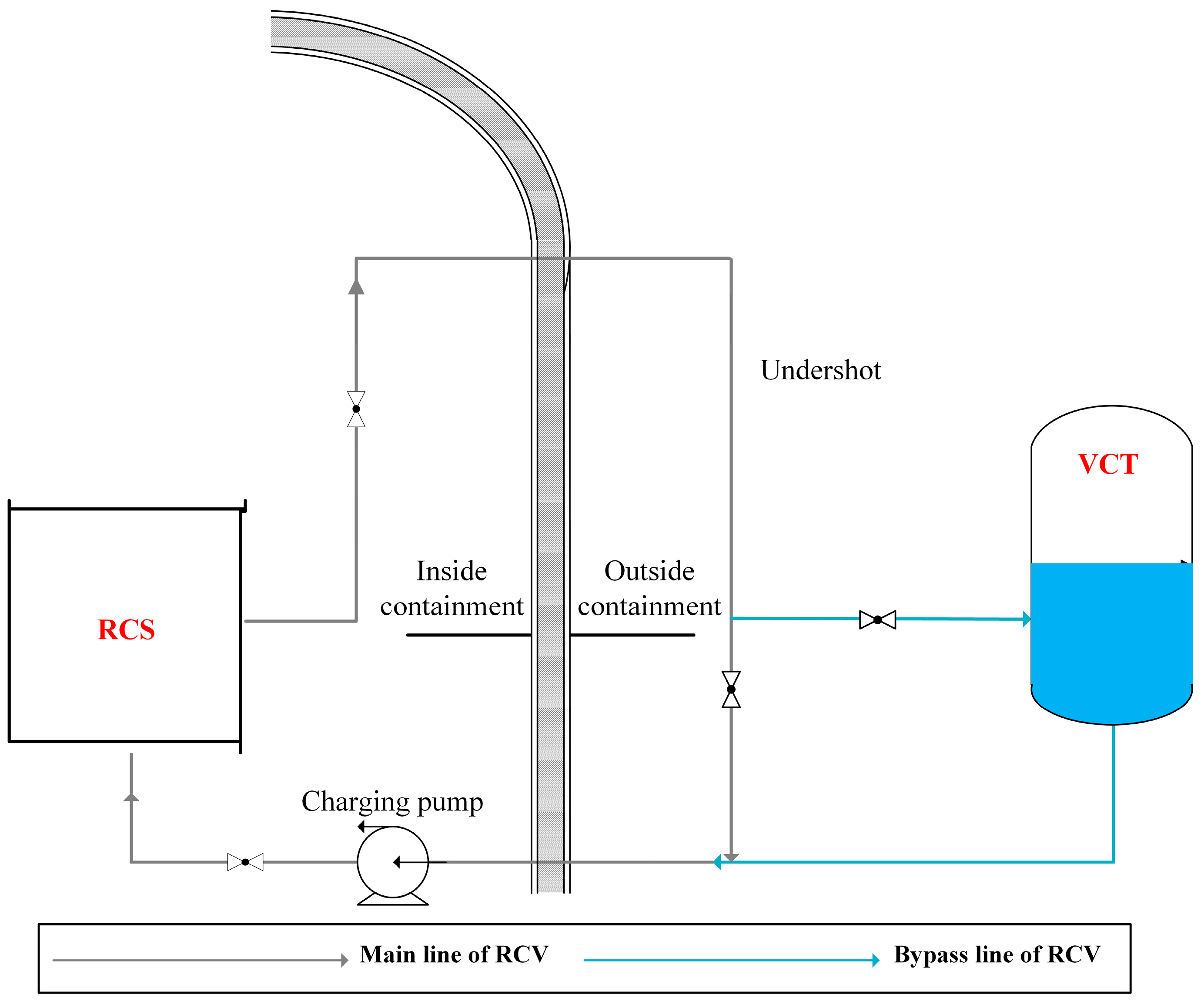
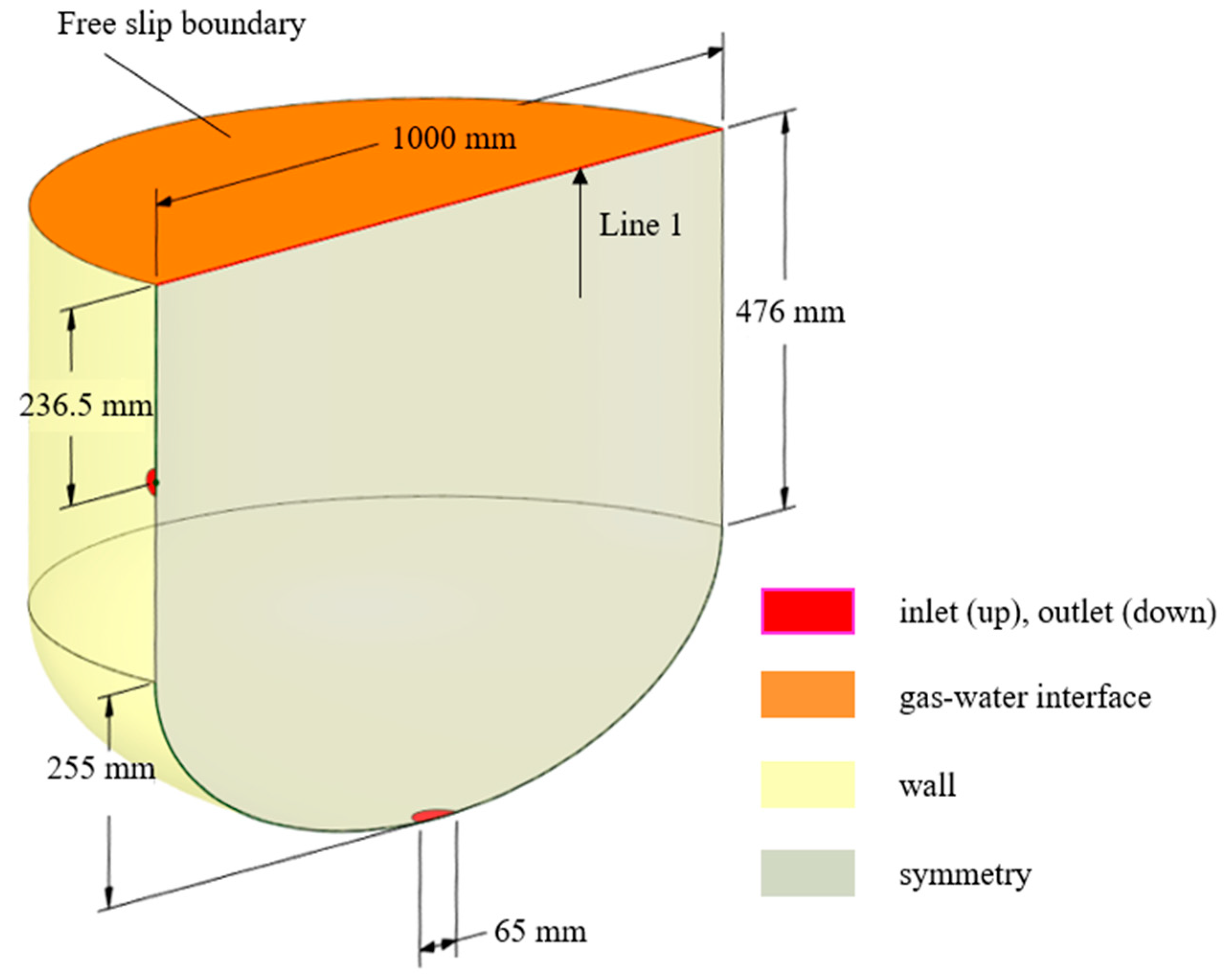
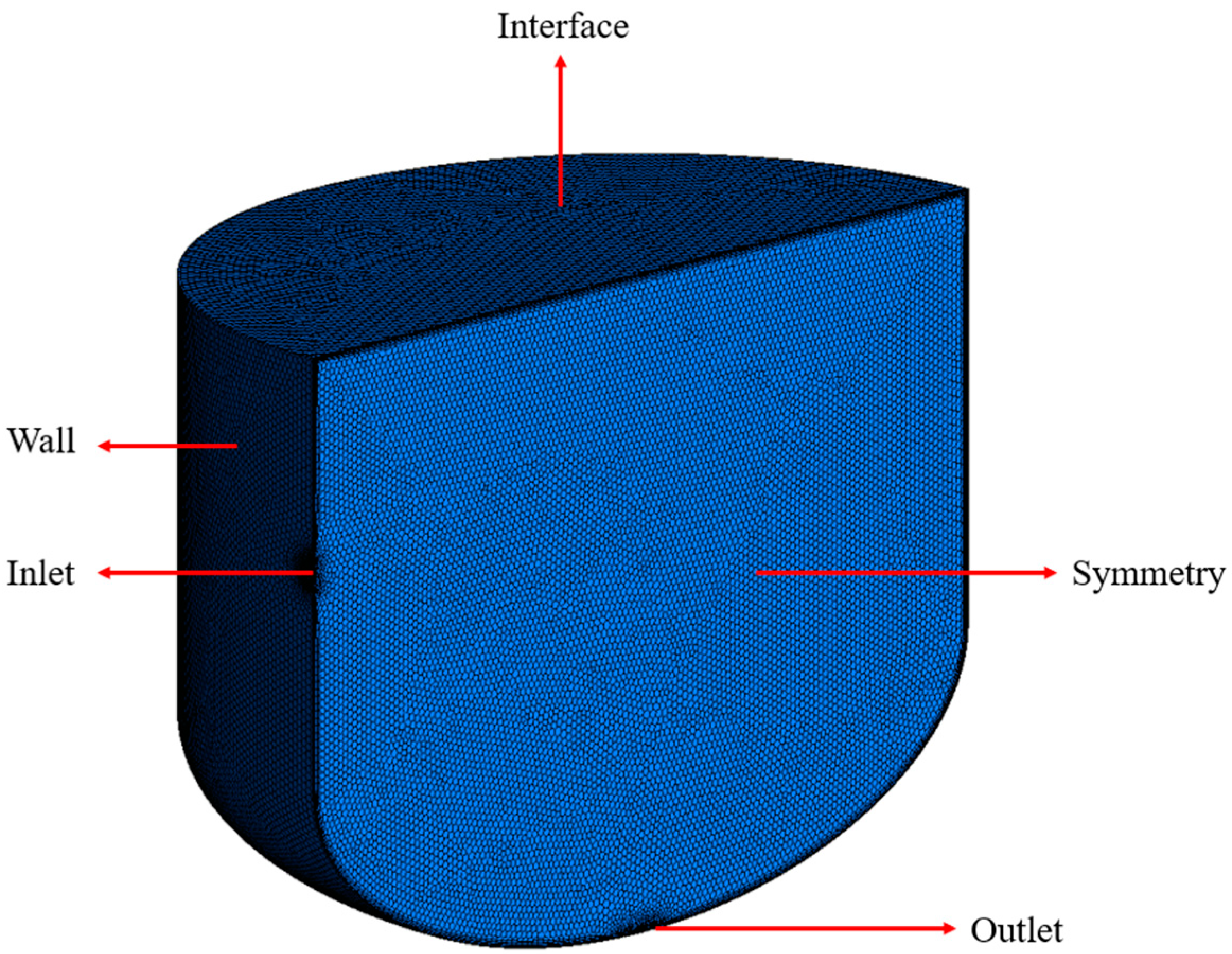
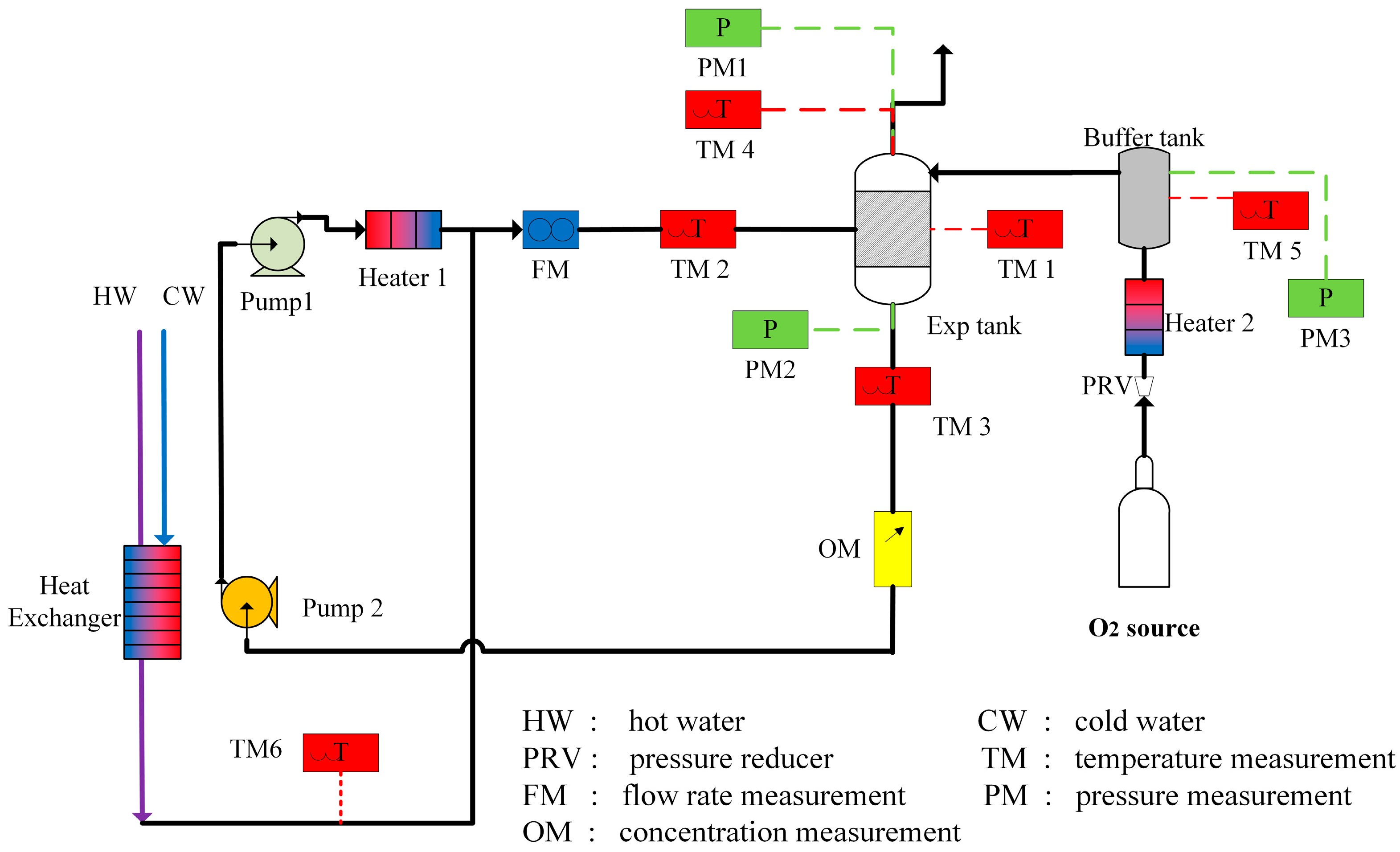
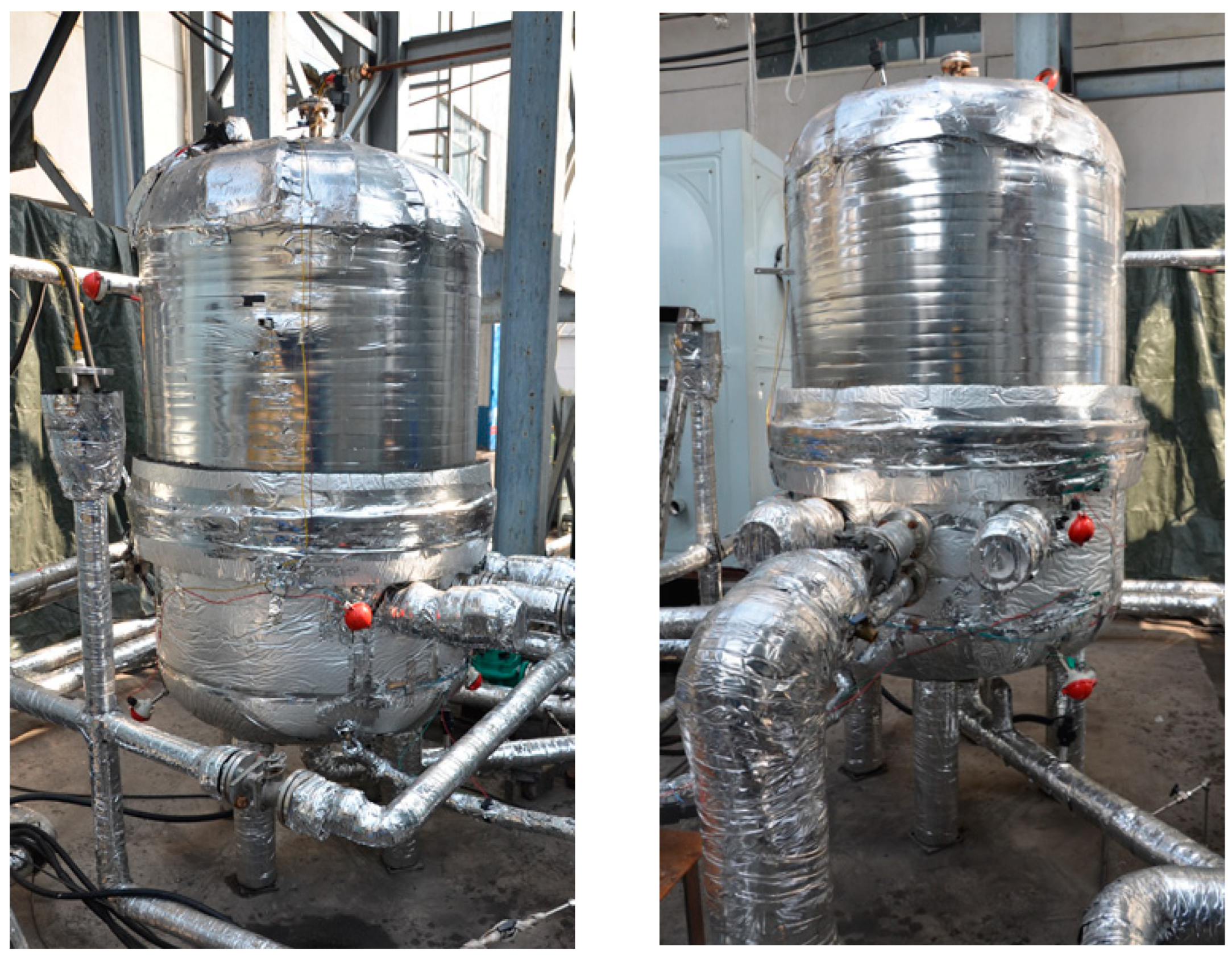
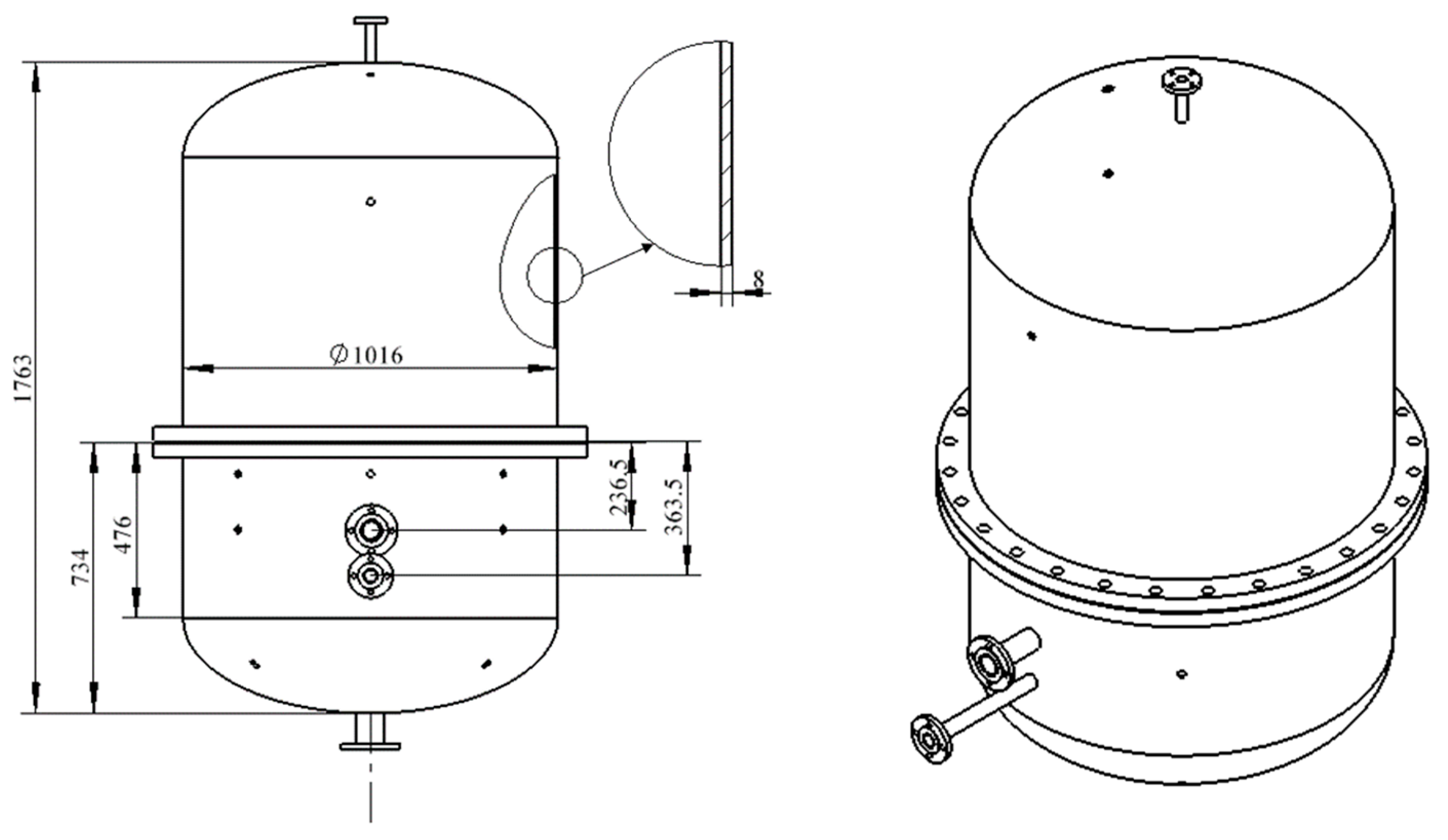
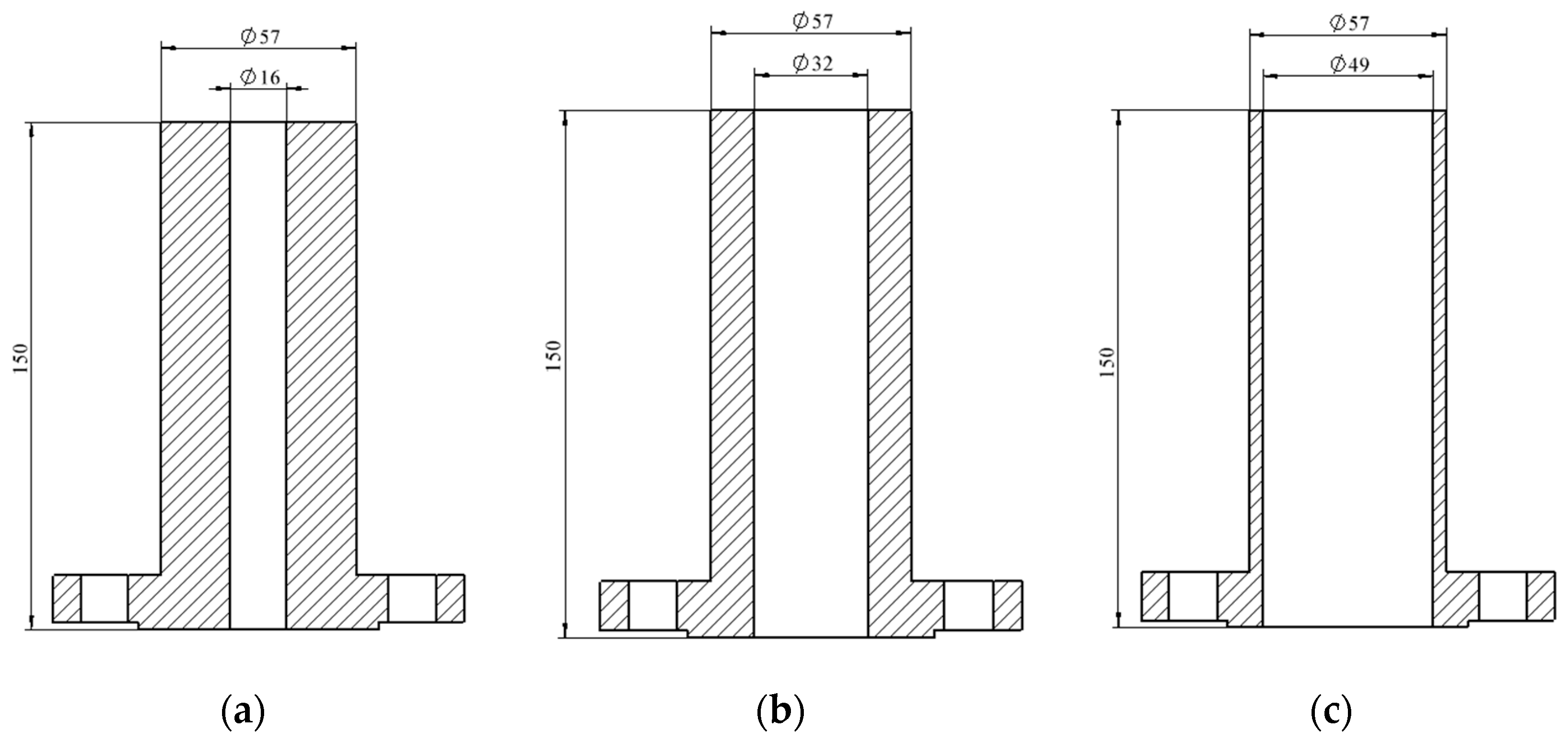
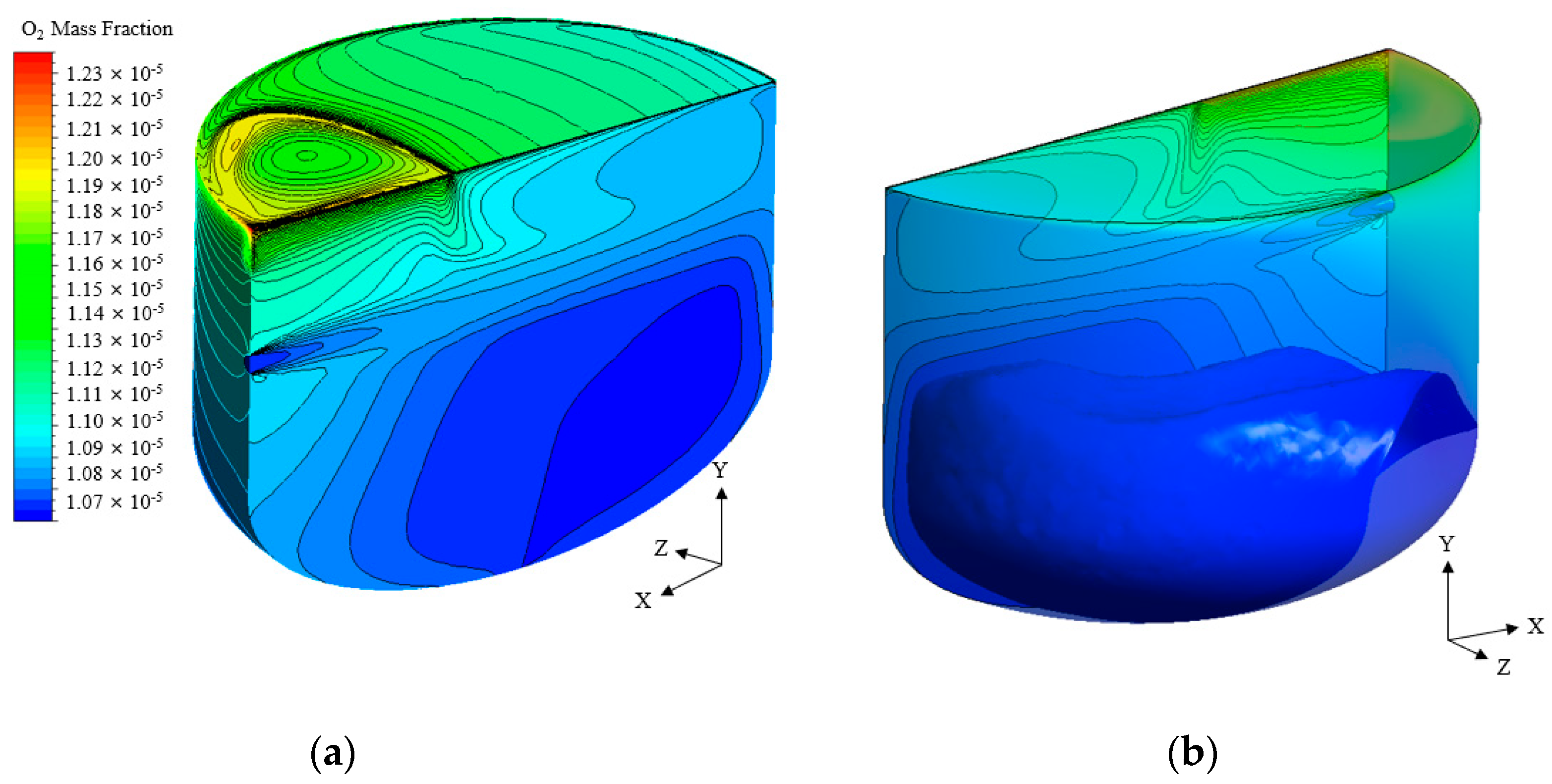

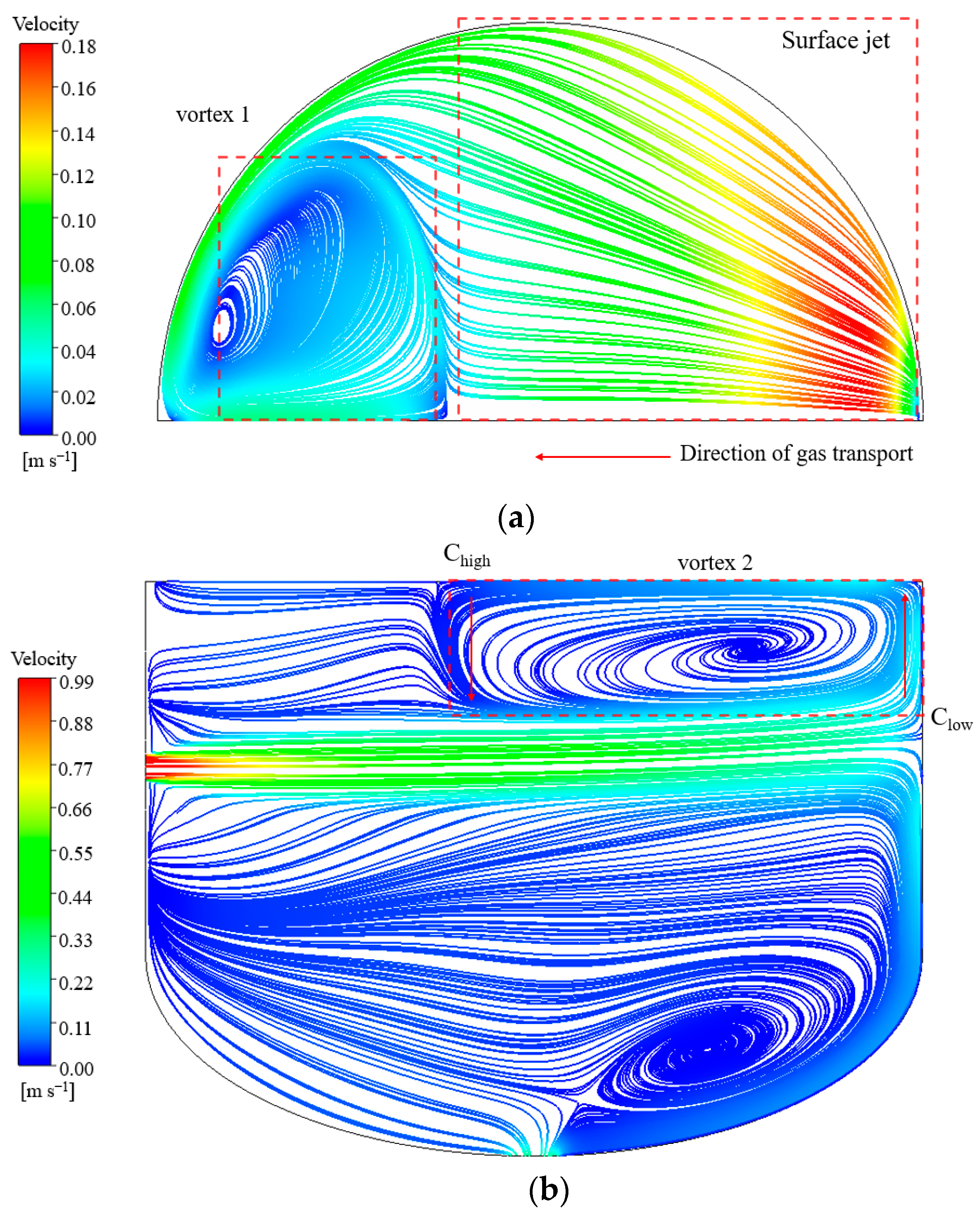
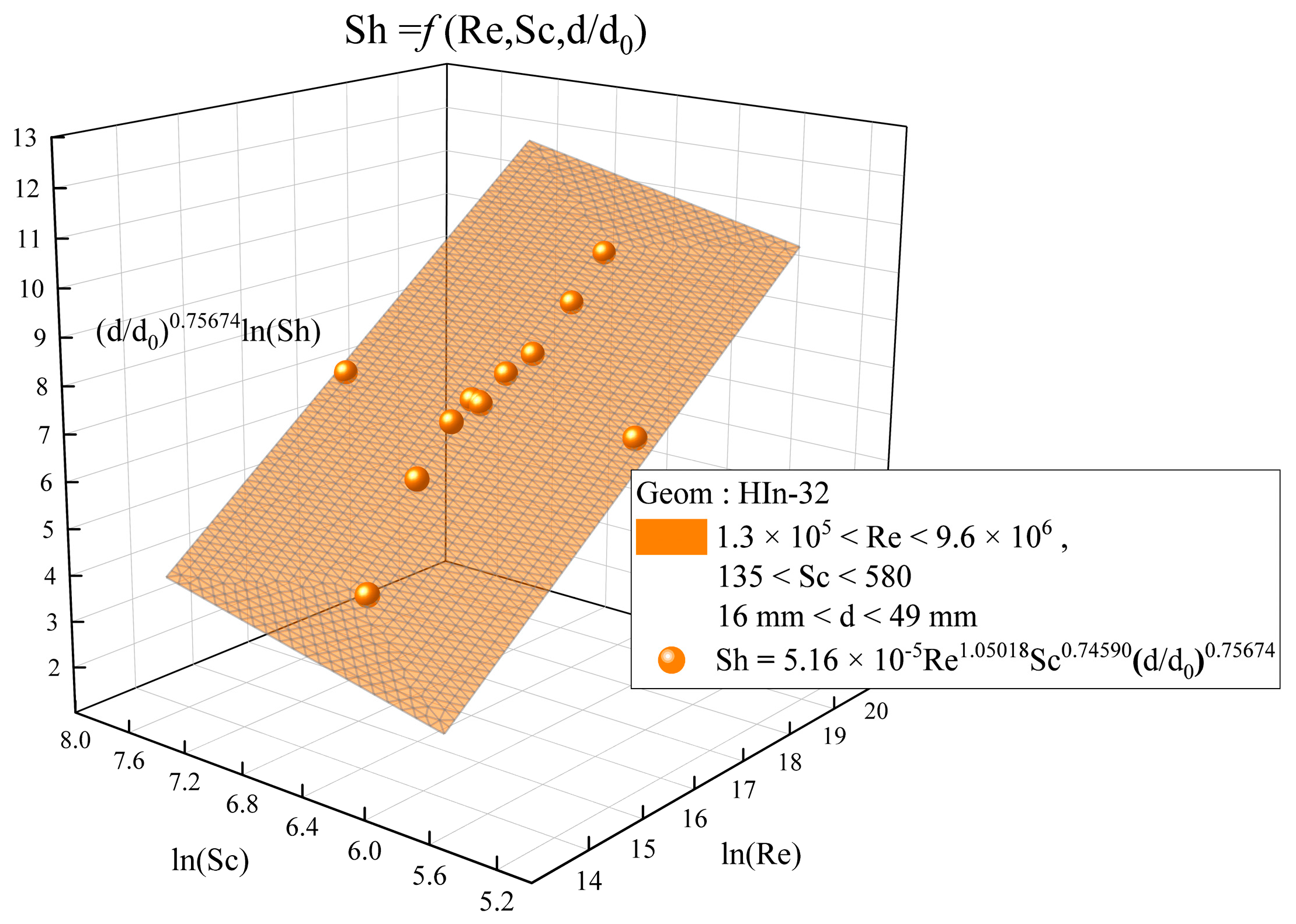
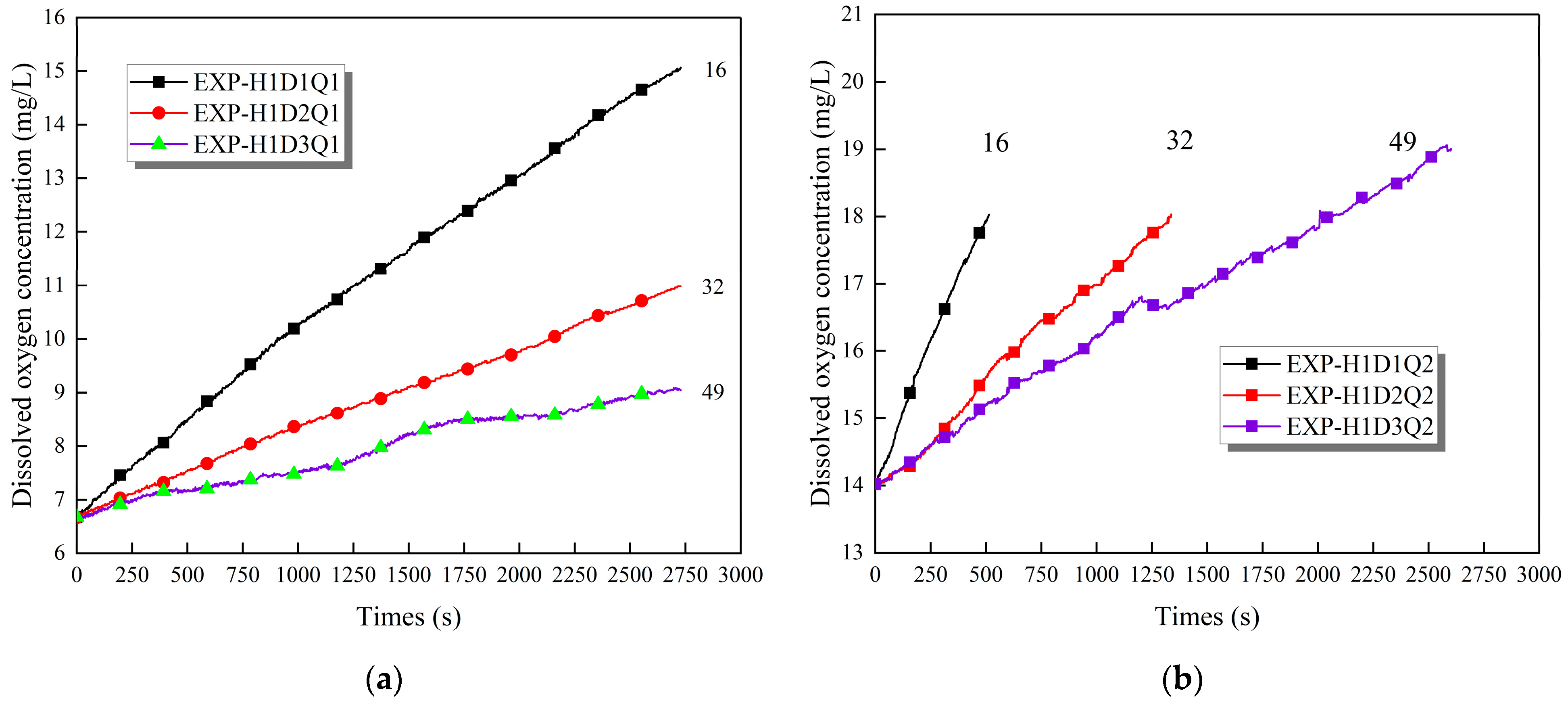
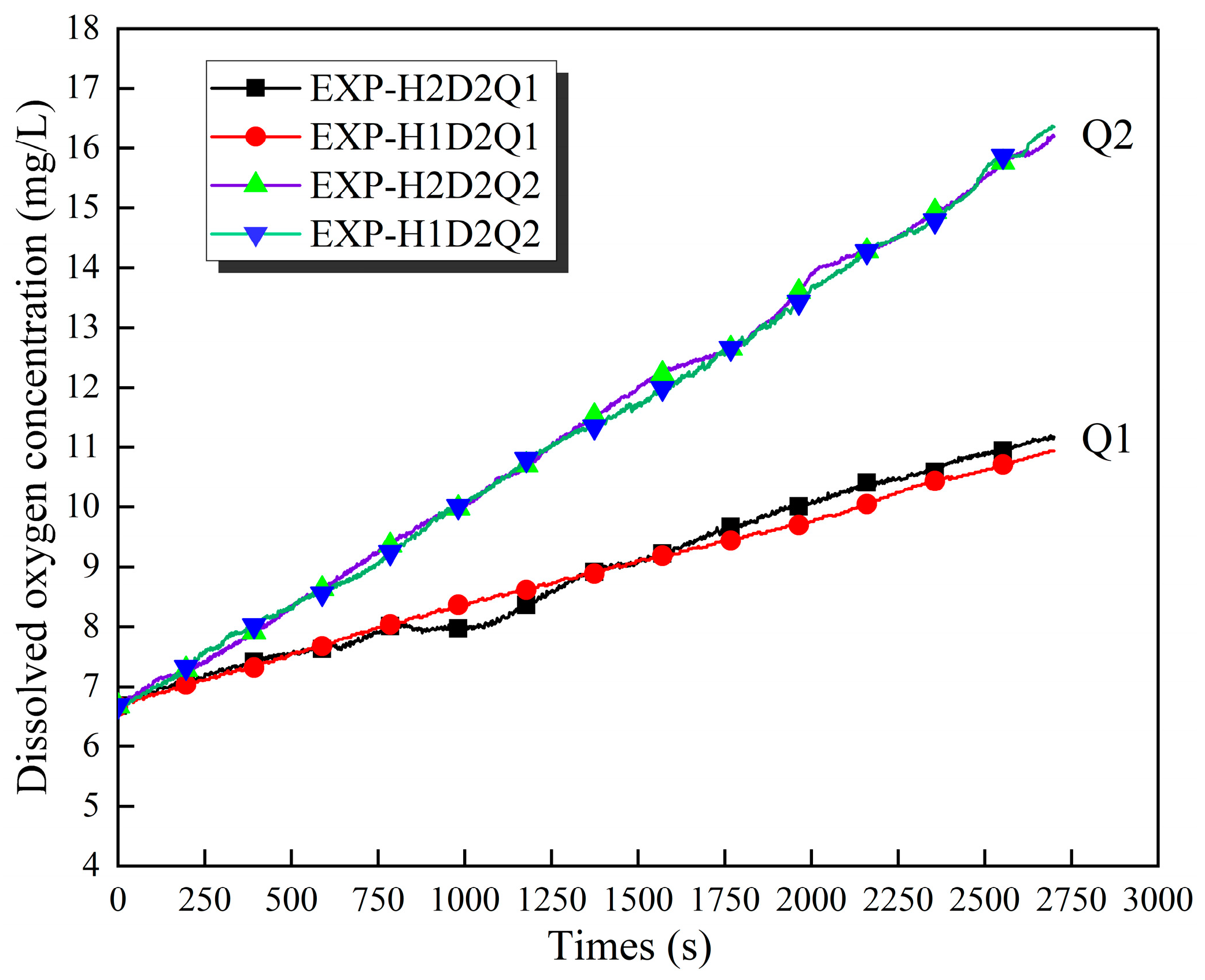
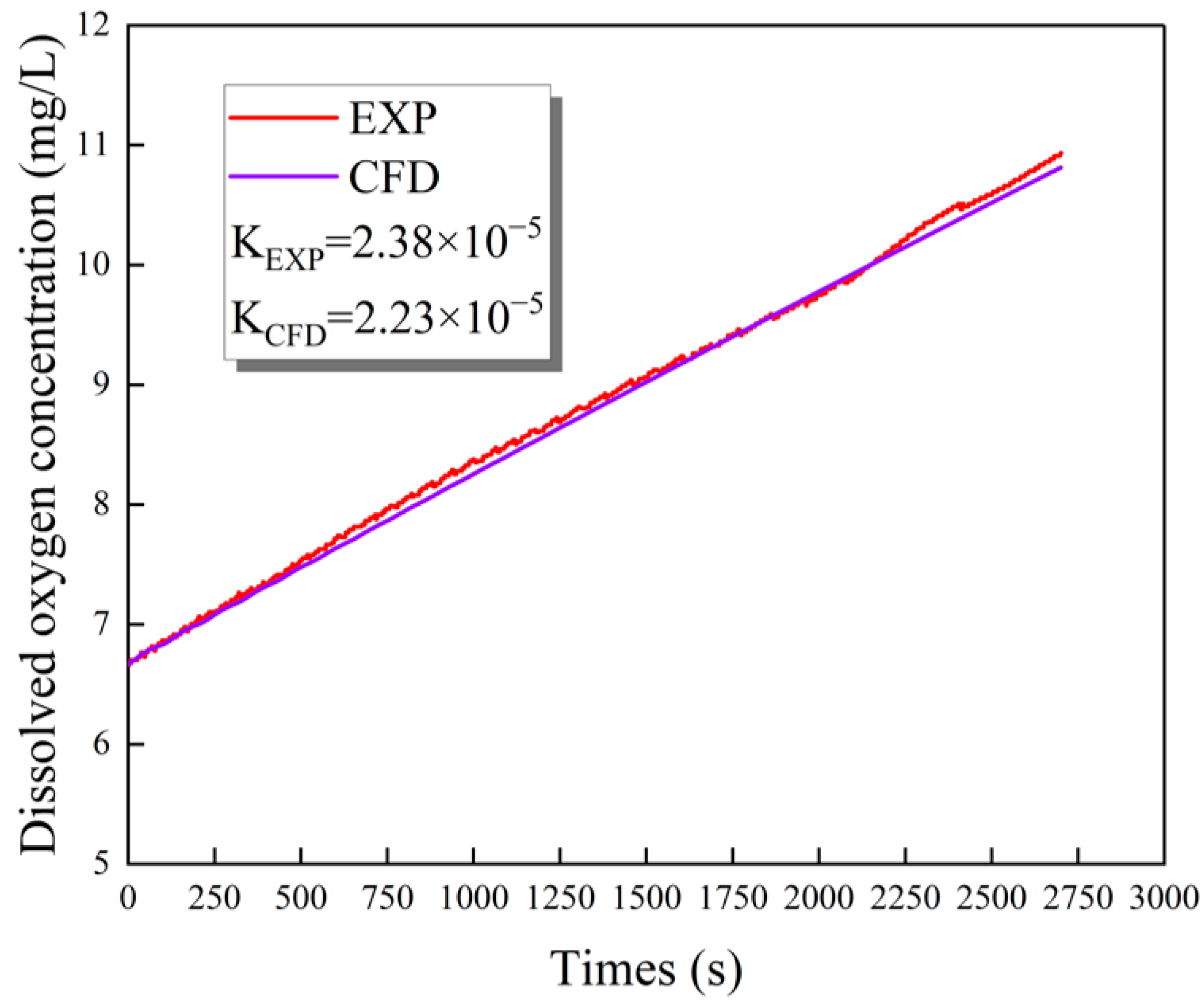
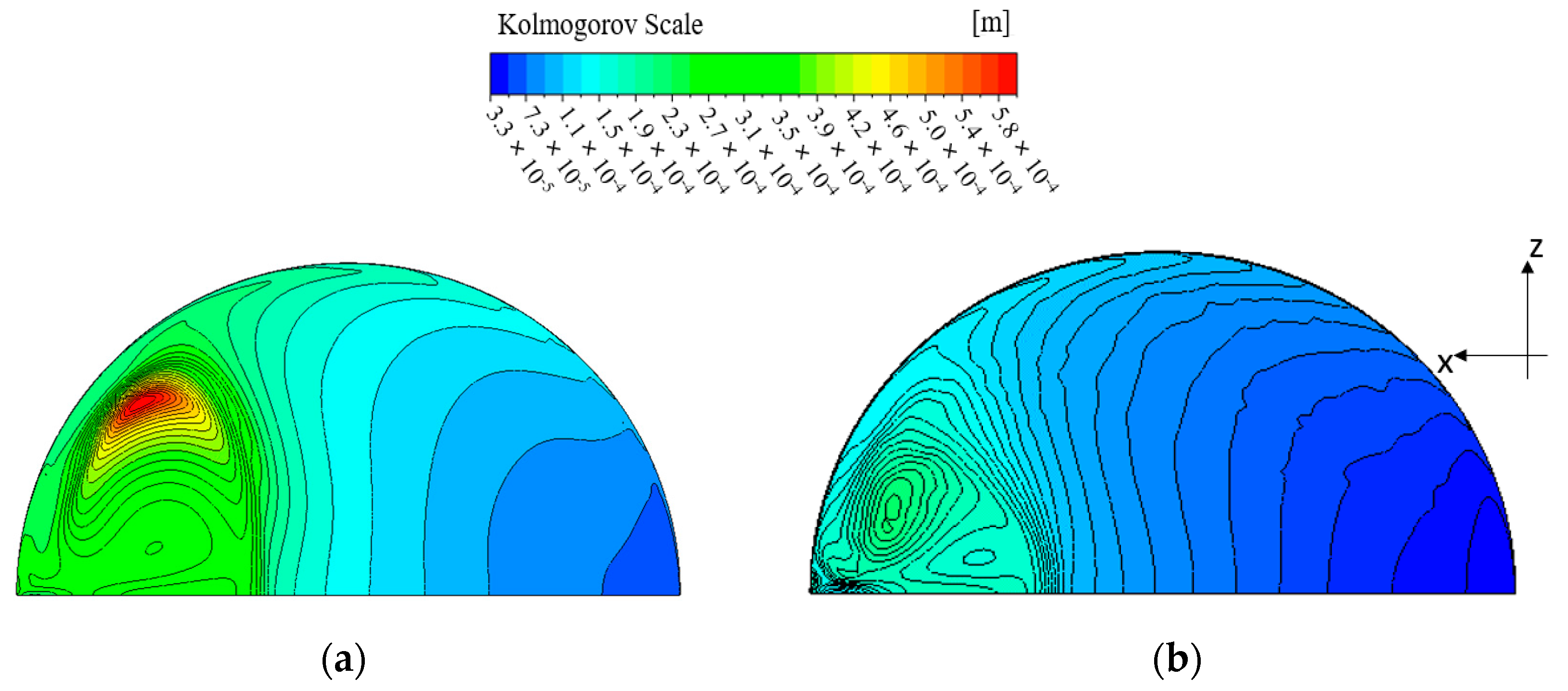

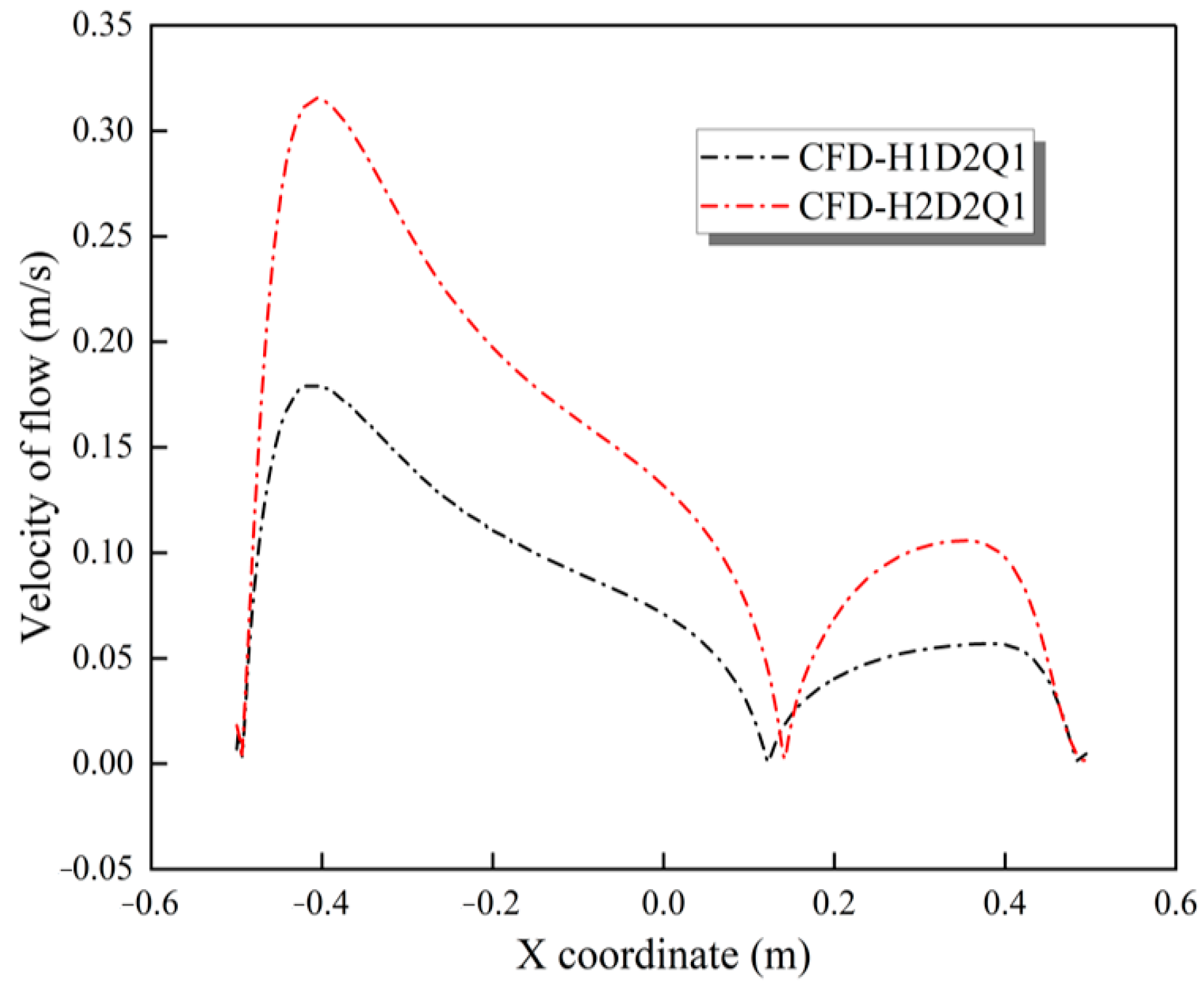

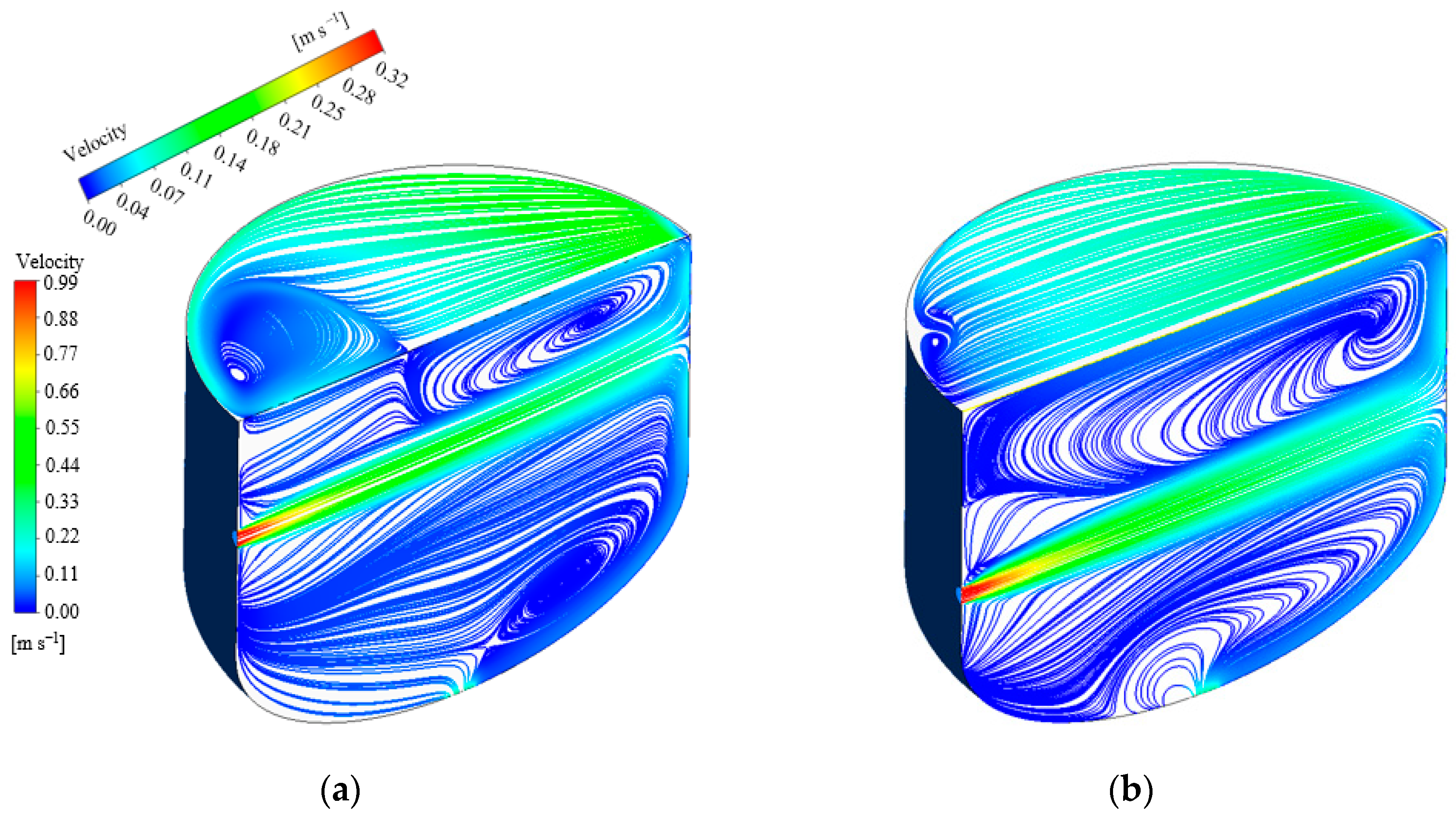
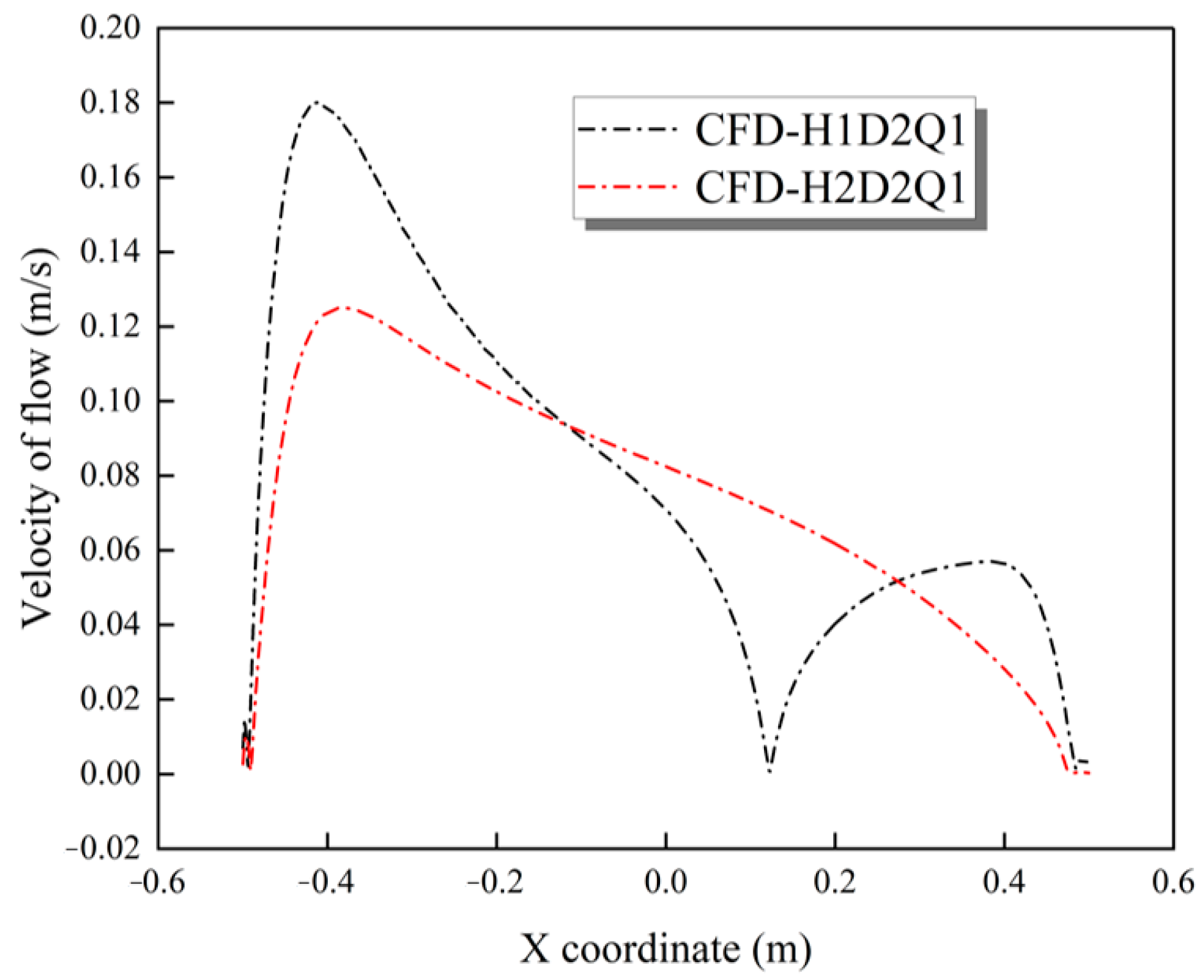

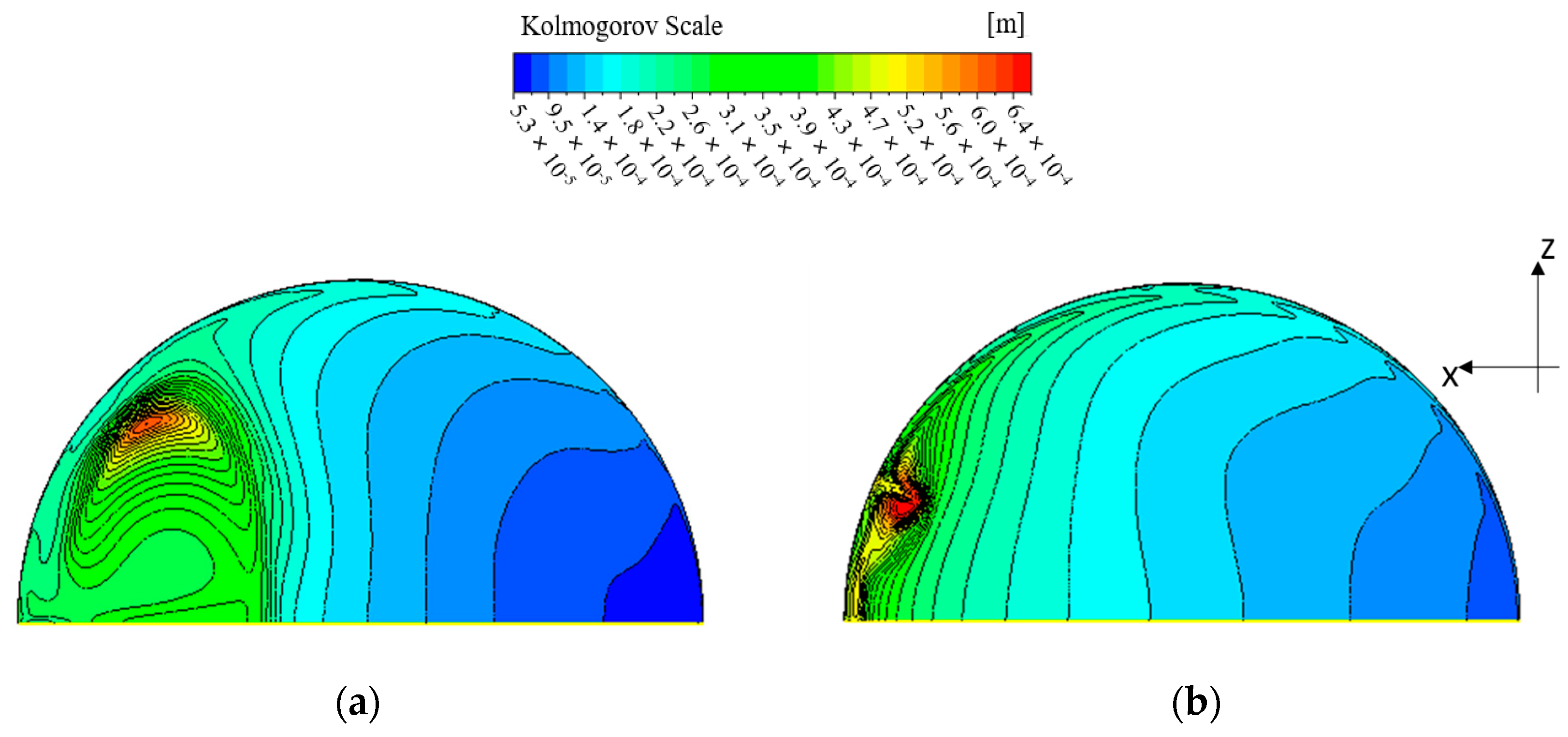
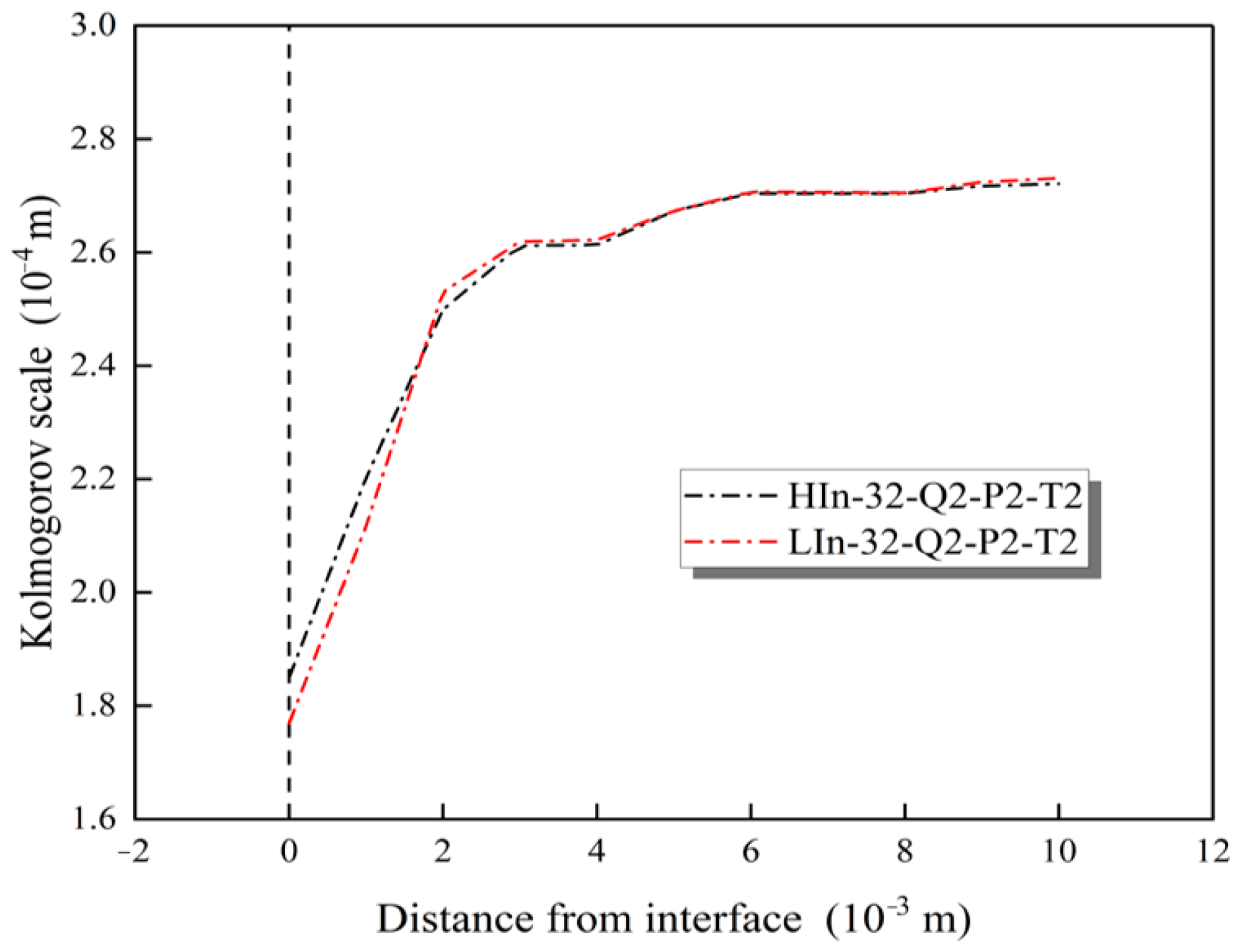
| Location | Boundary Type |
|---|---|
| Jet inlet | Velocity-Inlet |
| Tank bottom outlet | Pressure-Outlet |
| Tank wall surface | No-Slip wall surface |
| Symmetrical surface | Symmetry boundary |
| Gas–liquid interface | Zero-shear interface |
| Number | Inlet Height (mm) | Jet Diameter (mm) | Inlet Flow Rate (m3/h) | Total Pressure (kPa) | Fluid Temperature (°C) |
|---|---|---|---|---|---|
| CFD-H1D2Q1 | 236.5 | 32 | 2.80 | 140.0 | 30.0 |
| CFD-H2D2Q1 | 361.5 | 32 | 2.80 | 140.0 | 30.0 |
| CFD-H1D1Q1 | 236.5 | 16 | 2.80 | 140.0 | 30.0 |
| N (-) | KL (10−5 m/s) | H (-) | R (-) | (-) | (-) | P (-) | (%) | GCI (%) |
|---|---|---|---|---|---|---|---|---|
| 267,412 | 1.880 | 9.83 | - | - | converged | 9.59 | 1.90 | 0.42 |
| 500,349 | 2.205 | 7.97 | 1.23 | 0.3250 | ||||
| 904,440 | 2.248 | 6.55 | 1.22 | 0.0430 |
| Number | Inlet Height (mm) | Jet Diameter (mm) | Inlet Flow Rate (m3/h) | Total Pressure (kPa) | Fluid Temperature (°C) |
|---|---|---|---|---|---|
| EXP-H1D2Q1 | 236.5 | 32 | 2.79 | 140.6 | 29.2 |
| EXP-H1D1Q2 | 236.5 | 16 | 5.59 | 140.7 | 29.6 |
| EXP-H1D2Q2 | 236.5 | 32 | 5.60 | 139.2 | 30.5 |
| EXP-H1D3Q2 | 236.5 | 49 | 5.60 | 140.6 | 29.1 |
| EXP-H2D2Q1 | 361.5 | 32 | 2.80 | 141.0 | 29.0 |
| EXP-H1D1Q1 | 236.5 | 16 | 2.82 | 139.3 | 30.3 |
| EXP-H1D3Q1 | 236.5 | 49 | 2.78 | 141.1 | 30.0 |
Disclaimer/Publisher’s Note: The statements, opinions and data contained in all publications are solely those of the individual author(s) and contributor(s) and not of MDPI and/or the editor(s). MDPI and/or the editor(s) disclaim responsibility for any injury to people or property resulting from any ideas, methods, instructions or products referred to in the content. |
© 2023 by the authors. Licensee MDPI, Basel, Switzerland. This article is an open access article distributed under the terms and conditions of the Creative Commons Attribution (CC BY) license (https://creativecommons.org/licenses/by/4.0/).
Share and Cite
Hu, J.; Li, W.; Chi, X.; Wang, N. Study on the Effect of Structural Parameters of Volume Control Tank on Gas–Liquid Mass Transfer. Energies 2023, 16, 4991. https://doi.org/10.3390/en16134991
Hu J, Li W, Chi X, Wang N. Study on the Effect of Structural Parameters of Volume Control Tank on Gas–Liquid Mass Transfer. Energies. 2023; 16(13):4991. https://doi.org/10.3390/en16134991
Chicago/Turabian StyleHu, Jian, Weiguang Li, Xiangyu Chi, and Naihua Wang. 2023. "Study on the Effect of Structural Parameters of Volume Control Tank on Gas–Liquid Mass Transfer" Energies 16, no. 13: 4991. https://doi.org/10.3390/en16134991
APA StyleHu, J., Li, W., Chi, X., & Wang, N. (2023). Study on the Effect of Structural Parameters of Volume Control Tank on Gas–Liquid Mass Transfer. Energies, 16(13), 4991. https://doi.org/10.3390/en16134991







